Do you have a question about the Derbi GP1 125 E3 and is the answer not in the manual?
Chapter on engine starting, riding techniques, and break-in.
Chapter covering routine maintenance and checks.
Chapter containing technical data for the scooter.
Operation of the ignition switch and key positions.
Warns about insufficient oil pressure, which is critical for the engine.
Explanation of ignition key positions: ON, engine stopped, and steering lock.
Critical safety warnings related to refueling, including fire hazards.
Detailed instructions on how to start the engine, with or without electric start.
Guidelines for the engine break-in period to ensure longevity and performance.
Detailed instructions for starting the engine using the electric starter.
Warning about the toxicity of exhaust fumes in enclosed spaces.
Steps to take if the engine is flooded.
How to start the engine after refueling due to fuel exhaustion.
Recommended practices during the running-in period for engine longevity and smooth operation.
Advice on avoiding prolonged clutch slip to prevent overheating.
Strict warning against riding under the influence of alcohol, drugs, or medication.
Advice to avoid sudden acceleration for better fuel economy and reduced wear.
Warning about avoiding low-speed starts with little throttle to prevent transmission overheating.
Procedures for checking and maintaining engine oil levels.
Overview of the carburetor and its importance for engine performance.
Steps for adjusting the engine's idle speed.
Overview of the fuel injection system and its benefits over carburetors.
Information on how the injection system is adjusted and warnings about modifications.
Detailed steps for cleaning the air filter foam.
Importance of engine oil and normal consumption factors.
Step-by-step guide to checking the engine oil level with the engine cold.
How to add oil, including quantity and precautions.
Explanation of the oil pressure warning light and what to do if it illuminates.
Steps for draining oil, replacing filter, and refilling with new oil.
Steps and intervals for checking the coolant level.
Critical warning about overfilling the coolant reservoir and potential dangers.
How to drain, refill, and bleed the coolant system.
Explanation of fuse types, location, and replacement procedure.
Warning against using incorrect fuse amperage to prevent electrical damage.
Recommendations for battery care, including charging and handling precautions.
Warning about the maximum charging rate to avoid battery damage.
How to replace the battery and warnings about disposal.
Warning against disconnecting battery cables while the engine is running.
Safety instructions for handling battery electrolyte due to its corrosive nature.
Information on spark plug brands, removal, cleaning, and gap verification.
Warning about using incorrect spark plugs and potential engine damage.
Warning regarding the electrode gap and proper replacement/adjustment procedures.
Recommended tyre pressures for different riding conditions.
Warning about the dangers of riding with excessively worn tires and recommendations for replacement.
Explanation of the four preload positions and how to adjust them.
Instructions for checking, topping up, and changing brake fluid.
How to identify worn brake pads and the causes of brake squealing.
How to identify and address air in the brake system.
Step-by-step guide for bleeding air from the brake system.
General advice and initial troubleshooting steps for common breakdowns.
How to check the fuel supply to the carburetor.
How to check for spark from the ignition system.
Essential checks to perform before starting the scooter daily.
Specific maintenance tasks for the initial service and break-in period.
Detailed technical specifications for the scooter.
Key engine parameters such as bore, stroke, and displacement.
Chapter on engine starting, riding techniques, and break-in.
Chapter covering routine maintenance and checks.
Chapter containing technical data for the scooter.
Operation of the ignition switch and key positions.
Warns about insufficient oil pressure, which is critical for the engine.
Explanation of ignition key positions: ON, engine stopped, and steering lock.
Critical safety warnings related to refueling, including fire hazards.
Detailed instructions on how to start the engine, with or without electric start.
Guidelines for the engine break-in period to ensure longevity and performance.
Detailed instructions for starting the engine using the electric starter.
Warning about the toxicity of exhaust fumes in enclosed spaces.
Steps to take if the engine is flooded.
How to start the engine after refueling due to fuel exhaustion.
Recommended practices during the running-in period for engine longevity and smooth operation.
Advice on avoiding prolonged clutch slip to prevent overheating.
Strict warning against riding under the influence of alcohol, drugs, or medication.
Advice to avoid sudden acceleration for better fuel economy and reduced wear.
Warning about avoiding low-speed starts with little throttle to prevent transmission overheating.
Procedures for checking and maintaining engine oil levels.
Overview of the carburetor and its importance for engine performance.
Steps for adjusting the engine's idle speed.
Overview of the fuel injection system and its benefits over carburetors.
Information on how the injection system is adjusted and warnings about modifications.
Detailed steps for cleaning the air filter foam.
Importance of engine oil and normal consumption factors.
Step-by-step guide to checking the engine oil level with the engine cold.
How to add oil, including quantity and precautions.
Explanation of the oil pressure warning light and what to do if it illuminates.
Steps for draining oil, replacing filter, and refilling with new oil.
Steps and intervals for checking the coolant level.
Critical warning about overfilling the coolant reservoir and potential dangers.
How to drain, refill, and bleed the coolant system.
Explanation of fuse types, location, and replacement procedure.
Warning against using incorrect fuse amperage to prevent electrical damage.
Recommendations for battery care, including charging and handling precautions.
Warning about the maximum charging rate to avoid battery damage.
How to replace the battery and warnings about disposal.
Warning against disconnecting battery cables while the engine is running.
Safety instructions for handling battery electrolyte due to its corrosive nature.
Information on spark plug brands, removal, cleaning, and gap verification.
Warning about using incorrect spark plugs and potential engine damage.
Warning regarding the electrode gap and proper replacement/adjustment procedures.
Recommended tyre pressures for different riding conditions.
Warning about the dangers of riding with excessively worn tires and recommendations for replacement.
Explanation of the four preload positions and how to adjust them.
Instructions for checking, topping up, and changing brake fluid.
How to identify worn brake pads and the causes of brake squealing.
How to identify and address air in the brake system.
Step-by-step guide for bleeding air from the brake system.
General advice and initial troubleshooting steps for common breakdowns.
How to check the fuel supply to the carburetor.
How to check for spark from the ignition system.
Essential checks to perform before starting the scooter daily.
Specific maintenance tasks for the initial service and break-in period.
Detailed technical specifications for the scooter.
Key engine parameters such as bore, stroke, and displacement.

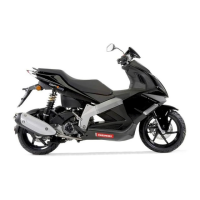

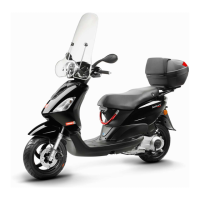
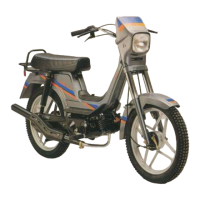
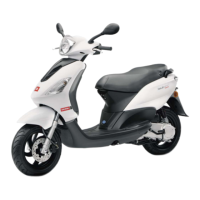
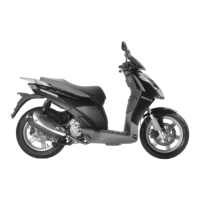

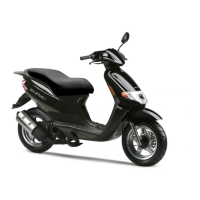


